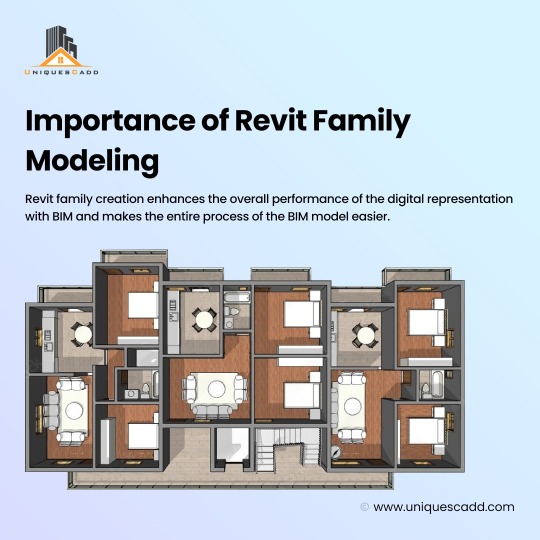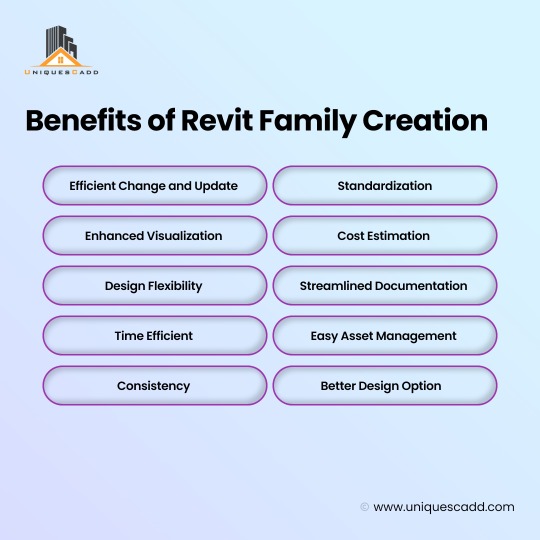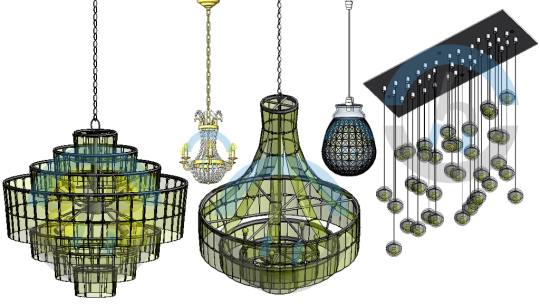#revit family creation
Text
Role of Revit Family Creation in BIM Modeling






With the inception of BIM came other groundbreaking technologies, such as Revit Family Creation, which has become an essential tool for architects and designers to enhance projects with their desired components visually.
Checkout how Revit Family can be used in BIM modeling.
#revit family creation#revit families creation#family creation in revit#revit family creation services#bim family creation#custom revit family creation services#bim content creation
1 note
·
View note
Text
Enhancing Formwork Detailing: The Transformative Power of BIM Modeling for Structural Contractors

Introduction
In the realm of construction, precision and efficiency are paramount. Structural contractors are tasked with the responsibility of translating architectural designs into tangible structures, often facing challenges in formwork detailing. Formwork, the temporary mold into which concrete is poured, demands meticulous planning and execution to ensure structural integrity and cost-effectiveness. Here's where Building Information Modeling (BIM) steps in as a game-changer, revolutionizing formwork detailing processes and empowering contractors to achieve unparalleled efficiency and accuracy.
Understanding Formwork Detailing
Formwork, often referred to as shuttering, serves as the temporary mold into which concrete is poured and allowed to harden. It's a critical component in concrete construction, influencing project timelines, costs, and structural integrity. Formwork detailing involves meticulous planning and design to ensure the formwork accurately conforms to the desired shape and dimensions of the concrete element being cast. Any inaccuracies or inefficiencies in formwork detailing can lead to delays, cost overruns, and compromised quality.
The BIM Advantage
Enter Building Information Modeling (BIM), a revolutionary technology that has reshaped the landscape of the construction industry. BIM is a digital representation of the physical and functional characteristics of a building, offering a comprehensive platform for collaborative design, visualization, and simulation. When applied to formwork detailing, BIM unlocks a myriad of benefits for structural contractors:
1. Enhanced Visualization and Planning
BIM enables contractors to visualize formwork designs in a 3D digital environment, providing a clear understanding of the structure's geometry and spatial relationships. With sophisticated modeling tools, contractors can simulate various formwork scenarios, optimizing layouts for efficiency and material utilization. This level of visualization facilitates early-stage problem-solving and informed decision-making, mitigating risks and minimizing costly errors during construction.
2. Accurate Quantity Takeoffs
One of the primary challenges in formwork detailing is accurately estimating material quantities. BIM streamlines this process by generating precise quantity takeoffs based on the digital model. By extracting data directly from the BIM environment, contractors can calculate the required formwork components with unparalleled accuracy, eliminating guesswork and potential overruns. This precision not only optimizes material procurement but also contributes to cost savings throughout the project lifecycle.
3. Seamless Collaboration and Coordination
BIM serves as a collaborative platform, facilitating seamless communication and coordination among project stakeholders. Structural engineers, architects, contractors, and subcontractors can work concurrently within the BIM environment, sharing real-time updates and feedback. This integrated approach fosters transparency and alignment throughout the formwork detailing process, minimizing conflicts and maximizing productivity. By breaking down silos and fostering collaboration, BIM ensures that everyone is on the same page, driving efficiency and synergy across the project team.
DISCUSS YOUR PROJECT REQUIREMENTS WITH OUR EXPERTISE: https://prototechsolutions.com/services/bim-modeling-services/
4. Clash Detection and Risk Mitigation
Formwork detailing involves intricate geometries and complex structural configurations, increasing the likelihood of clashes and interferences during construction. BIM's clash detection capabilities enable contractors to identify and resolve conflicts proactively, preventing costly rework and delays onsite. By simulating the formwork assembly within the digital model, contractors can anticipate potential clashes and design constraints, optimizing the construction sequence and minimizing disruption. This proactive approach to risk mitigation enhances project predictability and ensures smooth execution from design to delivery.
5. Iterative Design and Optimization
BIM empowers contractors to iterate on formwork designs iteratively, exploring various alternatives and optimizations before finalizing the construction plans. By leveraging parametric modeling and computational analysis, contractors can refine formwork layouts based on performance criteria, such as load-bearing capacity, material efficiency, and constructability. This iterative design process fosters innovation and continuous improvement, allowing contractors to achieve optimal solutions that balance technical requirements with project constraints. From complex geometries to challenging site conditions, BIM equips contractors with the tools and insights needed to tackle formwork detailing with confidence and efficiency.
6. Quantification and Cost Estimation
Another noteworthy advantage of BIM in formwork detailing is its ability to facilitate accurate quantification and cost estimation. BIM software enables automated takeoff procedures, extracting precise quantities of formwork materials based on the digital model. This data-driven approach eliminates the guesswork associated with manual quantity surveys and ensures that contractors procure the right amount of materials, reducing excess inventory and minimizing project costs. Additionally, BIM enables real-time cost tracking and analysis, empowering contractors to make informed decisions throughout the construction process.
7. Sustainability and Environmental Impact
In an era of increased emphasis on sustainability, BIM offers opportunities to minimize the environmental footprint of construction activities, including formwork detailing. By optimizing formwork designs for material efficiency and reducing waste, contractors can contribute to resource conservation and waste reduction efforts. Additionally, BIM enables lifecycle assessment and analysis, allowing stakeholders to evaluate the environmental impact of formwork materials and construction processes. By making informed decisions based on sustainability criteria, contractors can align formwork practices with green building principles and industry standards.
Conclusion:
In conclusion, BIM modeling represents a paradigm shift in how structural contractors approach formwork detailing. By harnessing the power of digital technology, contractors can enhance visualization, streamline design processes, and optimize construction workflows. From improved coordination and cost estimation to enhanced safety and sustainability, the benefits of BIM in formwork detailing are manifold. As the construction industry continues to evolve, embracing BIM as a fundamental tool for formwork detailing is essential for staying competitive and delivering projects of the highest quality. By embracing innovation and leveraging BIM capabilities, structural contractors can elevate formwork detailing to new heights, paving the way for a more efficient, resilient, and sustainable built environment.
#3D BIM MODELING#revit family creation#formwork detailing services#BIM modeling#structural contractors#formwork design#formwork detailing
0 notes
Text
Get high-quality Revit families quickly! Our cost-effective services streamline your workflow. Perfect for design professionals.
0 notes
Text
Revit Family Creation Services

Custom families for accurate design representation and increased productivity. Tailored, parametric Revit families. Enhance BIM modeling with our expert Revit Family Creation services, optimizing visualization and efficiency. | Virtual Building studio
0 notes
Text
6 Key Considerations When Choosing an BIM Service Provider

The rise of Building Information Modeling (BIM) represents nothing less than a revolution for the architectural, engineering, and construction industries, offering a dynamic, 3D model-based technology process that gives professionals the information and insight to more efficiently plan, design, construct, and manage building and infrastructure. In this increasingly competitive landscape, getting the right Architectural BIM services on your side to make the most of this powerful new technology becomes critical to the success of your project. Here are six key considerations to help you make an informed decision about the BIM service provider that's right for you.
1. Experience and Expertise
First and foremost is the experience of a BIM service provider. Look for a company with a demonstrable track record of success in delivering high-quality BIM projects similar to yours. Experience within your specific sector (residential, commercial, infrastructure, etc.) is especially worth noting because it means a BIM provider is more likely to appreciate the nuances and unique challenges of your domain. Also examine the provider’s level of expertise with BIM standards and protocols, as well as its proficiency with the latest BIM software and technologies.
2. Quality of Services
Do not sacrifice quality. Examine the BIM provider's quality control processes to ensure that they align with your project standards. This should include their approach to modeling accuracy, detail and adherence to international BIM standards such as ISO 19650. Ask for samples of their previous projects to assess the quality of their work. Good quality services will save you money in the long run, as they will reduce the need for rework and ensure that issues do not arise with the BIM model throughout the lifecycle of the project.
3. Collaboration and Communication
BIM is an inherently collaborative undertaking, involving stakeholders from across the project lifecycle. Your BIM services provider should be demonstrating a clear capacity to communicate and to take a collaborative approach. Look closely at their tools and processes for collaboration, particularly their use of cloud-based platforms that will allow BIM models to be shared, reviewed, and updated in real time by all the relevant players. Clear communication and an ability to collaborate will help to minimise errors and ensure that all parties are pulling in the same uniform direction through the project lifecycle.

4. Customization and Flexibility
Each project has unique requirements, and a one-size-fits-all approach rarely suffices in BIM services. Look instead for a BIM provider, who understands the need for customization, adjusting their services to fit your project’s unique scale, complexity, and timeline. One option may not fit all, even in a single project, and a flexible BIM service provider can be a key partner as you navigate the challenges of your project.
5. Cost-Effectiveness
While price alone should not dictate your evaluation of BIM service providers, it is a critical factor. Look for transparent pricing models. Ensure that the quality and scope of the services being offered are commensurate with the cost. Beware of extremely low quotes that may indicate compromise in either. Instead, look for a BIM provider whose cost structures are clearly captured in their pricing model, and whose services will ultimately bring long-term value to a project.
6. Support and Training
Finally, remember to consider the level of support and training an architectural BIM service provider offers. This is especially important if your team is less experienced with BIM. A provider that offers extensive support and training can help your team become adept at understanding the BIM models and integrating BIM processes into your project workflows, crucial for overcoming technical challenges, and to ensuring your project benefits fully from BIM.
Conclusion
The choice of Scan to BIM Services Provider is a critical one that can significantly impact the success of your project. By considering the six key factors highlighted above - experience and expertise, quality of services, level of collaboration and communication, customization and flexibility, cost effectiveness, and level of support and training—you can select a BIM provider that meets your project's specific needs and enhances its overall outcome. With the right partner, BIM can realize its full potential, driving efficiency, innovation, and value across the lifecycle of your project.
#bim services provider#architectural bim services#architectural 3d modeling services#architectural rendering services#architectural drafting services#revit family creation#revit content creation
0 notes
Text
1 note
·
View note
Text
Outsourcing BIM Modeling Services - Chudasama Outsourcing

Chudasama Outsourcing provides all types of architectural BIM Modeling services to countries like USA, UK, UAE, Canada, Australia, New Zealand and Europe as well. Our team handles BIM modeling, Revit 3D Modeling, Revit Family Creation, Structural BIM Services, laser scan point cloud to BIM, CAD to BIM Conversion, Clash Detection and much more outsourcing work. If you want to do outsourcing work then you can contact us at [email protected]. We offer you outsourcing work at affordable prices.
For more information visit our website: https://caddraftingservices.in/services/bim-services.html
#outsource bim services#bim outsourcing services#bim modeling services#bim models services#3d bim modeling services#3d revit bim models#3d bim models services#3d bim modeling#3d bim models#revit family creation#revit bim services#revit modeling#bim services#building information modeling#structural bim services#revit modeling services#chudasama outsourcing#cad drafting services#COPL
0 notes
Text
Best Revit MEP Modeler for Building Contractors
Revit MEP aids in the creation of precise 3D coordination models for mechanical, electrical, and plumbing components. It enables all project participants, including contractors and builders, to easily exchange and communicate their models with one another.
We deliver MEP design build solutions for residential, commercial, and industrial buildings with Autodesk Revit MEP software. Our expert MEP engineers design clash coordinated Mechanical/HVAC, Electrical, Plumbing, and Fire Protection services.
Our Revit MEP Modeler are specialized in developing accurate and detailed MEP modeling with required LOD and as per the BIM execution plan offering the following Revit MEP Modeling services for building contractors:
- MEP 3D BIM modeling
- MEP shop drawings
- MEP Revit Family Creation
Top BIM is the best Revit MEP Modeler in USA. Contact us today and get a FREE quote!
#Revit#MEP Modeling#BIM Model#MEP design#building design#3D BIM modeling#shop drawings#Revit Family Creation
0 notes
Text
HVAC Revit Family Creation Services

We offer the best Revit family creation services for architecture firms, design-build companies, and product manufacturers. We provide Revit library creation services for architectural, structural, and MEP components of buildings. This will help you to focus on the bigger picture of the design, while we save your time and effort by creating BIM objects.
0 notes
Text

Electrical BIM Modeler
#bim modeling services#3d model#electrical#buildings#aec#revitmep#revit family creation#revit modeling#navisworks#autocad#coordinating
1 note
·
View note
Text
Advantages of Revit Family Creation to AEC Professionals

Revit Family Creation is enhanced and makes the process of BIM modeling easier. This technology has been considered one of the groundbreaking techniques in BIM. Besides, Revit families ensure any changes to class will be reflected throughout the project design. This saves time, money, and effort for designers. UniquesCADD offers BIM services integrated with Revit family creation, ensuring the reliability and accuracy of the project.
#revit family creation#revit families creation#revit family creation services#bim family creation#family creation in revit#custom revit family creation services#bim content creation
1 note
·
View note
Text
Creation of Revit Family for Parametric Product Design

Revit family creation or BIM content creation is the process of creating a library of custom-building products or mechanical elements that any changes to a particular family type are automatically updated throughout the entire project elements of the same family type.
When design engineers are working on a considerable big construction project it is difficult for them to create a model of every building product or mechanical component multiple times, so they use the Autodesk Revit platform to create parametric Revit families of that element. Read this article to know why BIM content creation is important for building product manufacturers. https://bit.ly/3XVZTI7
#Revit Family Creation#BIM Content Creation#Parametric Families#Building Products#Plumbing Elements#Plumbing#Manufacturers
0 notes
Text
Explain Clash Detection Best Practices and Tips for Seamless Implementation

Clash detection has become an essential tool in the dynamic field of building and design, particularly when working with MEP (Mechanical, Electrical, and Plumbing) systems. Clash detection is seamlessly integrated to guarantee early conflict identification and resolution in the project lifecycle, avoiding expensive rework and delays. With an emphasis on MEP systems specifically, we will examine the best practices and implementation advice for clash detection in this blog post.
Understanding Clash Detection:
The process of identifying spatial conflicts between different architectural components is known as clash detection. This procedure is much more important when dealing with MEP systems because they are complex and need to coexist peacefully in the same physical location.
Best Practices for Clash Detection:
Early Collaboration:
Detect conflicts before construction begins by starting clash detection early in the design process. Encourage collaboration among architects, engineers, and contractors to promote a comprehensive approach to conflict resolution.
Utilize BIM Technology:
BIM, or building information modeling, is essential to clash detection. Utilize BIM software to generate a comprehensive digital depiction of the project, facilitating a more precise evaluation of possible conflicts among the MEP systems.
Define Clear Protocols:
Within the project team, clearly define procedures and workflows for clash detection. Establish roles, deadlines, and lines of communication to guarantee effective dispute resolution.
Regular Updates and Reviews:
Conduct regular clash detection reviews throughout the project lifecycle. As the design evolves, new clashes may emerge. Keeping a continuous eye on the clash detection process helps in maintaining a clash-free environment.
Prioritize Critical Systems:
Identify and prioritize clashes based on the criticality of systems. Focus on resolving conflicts in essential MEP components first to ensure the functionality and efficiency of the overall system.
Tips for Seamless Implementation:
Invest in Training:
Provide adequate training for the project team on clash detection tools and methodologies. A well-trained team is more likely to use the technology effectively, minimizing errors and optimizing clash resolution.
Automate Routine Checks:
Implement automated clash detection routines to streamline the process. Automation helps in detecting common clashes efficiently, allowing the team to focus on more complex and unique conflicts that require human intervention.
Document and Learn:
Keep a comprehensive record of clashes and their resolutions. This documentation serves as a valuable resource for future projects, enabling continuous improvement and learning from past experiences.
Regularly Update Models:
As the project progresses, ensure that the digital models are kept up-to-date. Regularly synchronize the BIM models with the latest design changes to maintain accuracy in clash detection results.
Conclusion:
Clash detection, especially within MEP systems, is a cornerstone in modern construction practices. By adopting best practices and implementing these tips, project teams can seamlessly navigate the complexities of clash detection. The result is not only the prevention of costly errors but also the creation of more efficient, collaborative, and successful construction projects.
0 notes
Text
Revit Family Creation services - Chudasama Outsourcing

Chudasama Outsourcing have vast expertise in the area of Revit Family Creation complements our more than ten years of experience managing BIM projects. Our Revit professionals work with us to create specialized, usable BIM components that can be incorporated into digital design and construction models. We have established a solid reputation as a trustworthy partner for all Revit Family projects thanks to our experience working with reputable construction and design firms.
0 notes
Text

Elevate your designs with our Architectural BIM Services, ensuring accuracy, clash prevention, improved project timelines and cost-effective outcomes.
#architectural design#architectural bim services#architectural 3d modeling services#architectural rendering services#architectural drafting services#revit family creation#revit content creation
0 notes
Text
Revit Family Creation Services - Enhancing Accuracy, Saving Time on Recreating Data
Do you want to enhance the accuracy of construction project? Save time and effort on recreating data for future usage through Revit family creation services. Choose Top BIM Company in USA as your BIM consultant and get improved 3D visualization, comprehensive collaboration and project efficiency. To schedule your free consultation, contact 240 899 7711 or [email protected].
#Revit Family Creation#revit bim modeling#revit architecture#revit mep#revit modeling#revit drafting
0 notes